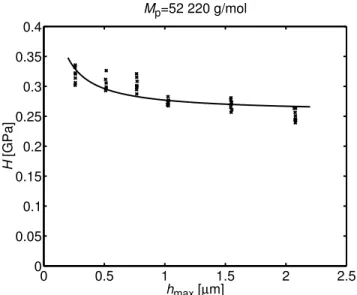Length-scale effects in yielding and damage
development in polymer materials
Jessica Agde Tjernlund
Licentiate thesis no. 93, 2005 TRITA, HFL-0394
KTH School of Engineering Sciences Department of Solid Mechanics
Royal Institute of Technology SE-100 44 Stockholm
List of appended papers
This thesis consists of an introduction and the following appended papers:
Paper A: Agde Tjernlund, J., Gamstedt, E.K., Xu, Z.-H., 2004. Influence of
molecular weight on strain-gradient yielding in polystyrene. Polymer Engineering and Science 44 (10), 1987-1997.
Paper B: Agde Tjernlund, J., Gamstedt, E.K., Gudmundson, P., 2005.
Length-scale effects on damage development in tensile loading of glass-sphere filled epoxy. Report 392, KTH Solid Mechanics, Royal Institute of Technology, S-100 44 Stockholm, Sweden. Submitted to an international journal.
In addition to this thesis, the work has resulted in the following publication:
Agde Tjernlund, J., Gamstedt, E.K., Gudmundson, P. An experimental investigation of the relationship between molecular structure and length scales in inelastic deformation of an amorphous thermoplastic. Presented at the IUTAM Symposium on “Size effects on material and structural behavior at micron- and nano-scales”, Hong Kong, 2004. To appear in the IUTAM book series, Kluwer Academic Publishers.
Introduction
Experimental observations have indicated that the geometrical size of components has an influence on the inelastic behaviour of polymers, as well as in metals (e.g. Fleck et al., 1994) and ceramics (e.g. Xu and Rowcliffe, 2002). There are indications that the smaller the specimen, the stronger is the material. Length-scale effects in yielding and fracture of metallic materials have been studied quite extensively. This field of research has been driven by miniaturization of e.g. electronic devices. Another driving force is the need for understanding of microstructure-property relations in composite materials and micro-electromechanical systems (MEMS) in the presence of large strain gradients. Polymers of different kinds are also used in applications such as electronic components, MEMS, composite materials and thin films. Despite the widespread use of polymers in these applications, the length-scale effect in yielding of polymers, as well as in related fracture and damage processes, has not been studied to any great extent. The set of underlying mechanisms for length-scale effects in various polymers is still unknown. Due to lack of knowledge, the higher strength at small scales can not be fully utilized without extensive component testing. More experiments and more realistic models for deformations in small scale components could open possibilities for improved design.
In crystalline metallic materials, geometrically necessary dislocations are of importance for the length-scale effect. The density of geometrically necessary dislocations is determined from gradients of the plastic strains, which introduce a length scale in a natural way (Nix and Gao, 1998). Microstructural dimensions like typical distances between dislocations and sizes of dislocation cells are also of importance (Bassim and Klassen, 1986). Several classical experiments on different metallic materials have confirmed that the plastic yield stress increases with decreasing structural dimensions (Fleck et al., 1994; Stölken and Evans, 1998; Nix and Gao, 1998). The length-scale effect is also qualitatively understood in ceramics. For example, when ceramics deform inelastically during indentation, shear bands consisting of cracks form. The typical distance between these shear bands is the controlling length-scale parameter (Hagan, 1980; Bull et al., 1989).
Polymer materials
Polymers can be divided into two groups, thermosets and thermoplastics. The structure of thermosets is a densely cross-linked network of polymer chains (see Fig. 1a), while thermoplastics are either amorphous (see Fig. 1b) or semicrystalline (see Fig. 1c), which essentially means a composite of stiffer crystallites mixed with the more compliant amorphous phase. Thermosets are generally relatively homogenous and isotropic due to a high and uniform cross-link density, whereas thermoplastics can show a considerable anisotropy due to molecular orientation. The only apparent structural length scale for an amorphous thermoplastic is the molecular length, whereas for a thermoset it is the average distance between adjacent cross-links. Lam and Chong (2000) have shown that a length-scale parameter associated with strain-gradient yielding is influenced by the cross-link distance in epoxies.
(a) (b) (c)
Fig. 1. Schematic illustration of (a) a cross-linked thermoset, (b) an amorphous thermoplastic, (c) a semicrystalline thermoplastic.
Length-scale effects in polymers
As for metals, most experimental studies on strain-gradient yielding in polymers have been conducted by micro-indentation. Experiments on both thermosets and thermoplastics (Briscoe et al., 1998; Chong and Lam 1999; Lam and Chong, 2001; Krupi ka, 2002) have shown that the hardness evaluated from shallow indents is larger than that resulting from a deeper one. This is due to a higher plastic yield stress in the presence of larger strain gradients. This method has generally, for simplicity reasons, been preferred in comparison to other test methods for quantification of
length-scale effects. Other test methods than indentation at a free surface would however be desirable for independent quantifications of length-scale effects.
Particle-filled polymers constitute a material of widespread use. Fillers of various dimensions are frequently added to make polymers stiffer, cheaper and improve on properties such as heat resistance, dimensional stability, fracture toughness and colour control. If a suitable interfacial adhesion can be assured and if strengthening length-scale effects can be invoked from small particles, a stronger material could be produced. The yielding process in the matrix is known to precede other damage processes in polymer-matrix composites. Debonding, matrix cracking, crazing and cavitation are other damage mechanisms that can set in prior to ultimate failure. These mechanisms may also show length-scale effects. For instance, Zhuk et al. (1993) showed that the debonding stress increases for decreasing glass particle size in polyethylene and polypropylene matrices and Pukánszky et al. (1994) found the same behaviour for polypropylene filled with calcium carbonate particles.
Previous works have also shown that finer particles (but the same volume fraction particles) can lead to improvements in strength properties, see Fig. 2. Mitsuishi et al. (1985) and Massam and Pinnavaia (1998) showed that the yield stress increases if the particles have smaller dimensions in polypropylene filled with calcium carbonate and epoxy-clay nanocomposites. Indications of the same behaviour with increasing yield stress for decreasing particle size have also been observed in polyester filled with glass spheres (Leidner and Woodhams, 1974). The tensile strength in solid- and hollow-glass filled rigid polyurethane composites (Landon et al., 1977) and in amine-epoxy-layered silicate nanocomposites (Kornmann et al., 2002) have been shown to increase for composites with smaller filler sizes. Also the strain to failure in polypropylene with glass beads (Sjögren and Berglund, 1997) showed the same trend.
Fig. 2. Schematic illustration of a stress-strain curve for a particle-filled polymer material. The experimental observations with increasing yield stress, tensile strength and strain to failure for decreasing particle size at constant volume fraction can be seen in the figure.
Zhandarov et al. (2001) measured increasing interfacial fracture toughness in pull-out of glass fibres from polyamide matrices with decreasing fibre diameters. A possible explanation for the experimental results above is a size effect. Since the particle/fibre diameters were small, the plastic deformation in the matrix occurred in a small volume with large strain gradients.
Several experiments have indirectly shown that there is a length-scale effect by measuring yield stresses for thin polymer films (Du et al., 2001) or interfacial shear strength in single-fibre composites with polymer matrix (Gamstedt et al., 2002; DiBenedetto and Lex, 1989; Fiedler and Schulte, 1997) that were higher than the bulk values.
These findings promote understanding that could be used in materials development to suppress deleterious damage mechanism by e.g. controlling the size distribution of reinforcing particles and interfacial adhesion. Further insight into the damage mechanisms and their length-scale dependence is however necessary.
Suggestions for future research
To be able to make use of the advantages with length-scale effects, for example in improved design, these effects have to be better understood by further examination. The first step is to do more experimental work with different polymer materials to quantify the effect. The underlying mechanisms for length-scale effects in various polymers have to be examined. A key question is: What controls the effect in different polymer materials at the molecular level? The time and temperature dependence of the length-scale effect could be useful to examine, since these dependencies are known to be significant for polymers. Realistic models that describe the phenomenon, preferably mechanism based, should be developed. More experimental work could be necessary to calibrate parameters of the models. Development and use of different and complementing characterization methods to quantify the length scale effects would be valuable in the formulation of general models. The models could be implemented with finite element method (FEM) to predict the behaviour in arbitrary geometries and loading cases.
Summary of appended papers
Paper A - Influence of molecular weight on strain-gradient yielding in polystyrene
The length-scale effects in inelastic deformations of the thermoplastic polystyrene (PS) have been experimentally quantified with respect to the molecular length. The experimental technique used was nano-indentation to various depths with a Berkovich indenter. The hardness has been calculated with the method by Oliver and Pharr (1992), and also by direct measurements of the area from atomic force microscopy. The experiments showed that length-scale effects in inelastic deformations exist in polystyrene at ambient conditions (see Fig. 3).
0 0.5 1 1.5 2 2.5 0 0.05 0.1 0.15 0.2 0.25 0.3 0.35 0.4 hmax [µm] H [GPa] Mp=52 220 g/mol
Fig. 3. The hardness, H, plotted against the maximum indentation depth, hmax, for the sample with molecular weight 52 220 g/mol
with least-squares fits of the function in Nix and Gao (1998).
The direct method gave a smaller hardness than the Oliver-Pharr method. It was also showed that the length-scale parameter according to Nix and Gao increases with increasing molecular weight (see Fig. 4). For high molecular weights, above a critical value of entanglement, there was no pertinent increase in the length-scale parameter.
Fig. 4. The length-scale parameter (Nix and Gao, 1998), h*, for
polystyrene plotted against their respective molecular weights of 4 920, 10 050, 19 880 and 52 220 g/mol.
Paper B - Length-scale effects on damage development in tensile loading of glass- sphere filled epoxy
In this study, the effect of glass-sphere size on the damage development in tensile loaded epoxy has been investigated. The first type of damage observed was debonding at the sphere poles, which subsequently grew along the interface between the glass spheres and epoxy matrix. These cracks were observed to kink out into the matrix in the radial direction perpendicular to the applied load.
The debond stresses increased with decreasing sphere diameter (shown in Fig. 5), whereas the length to diameter ratio of the matrix cracks increased with increasing diameter (shown in Fig. 6). These effects could not be explained by elastic stress analysis and linear-elastic fracture mechanics. A possible explanation is that there is a length-scale effect in the yield process which depends on the strain gradients. Cohesive fracture processes can also contribute to the influence of sphere size on matrix crack length.
Fig. 5. The diameter of the smallest particle with damaged matrix (*) and
the largest sphere without damaged matrix ( ) are indicated for both the applied stress and the stress concentration at the pole d. To the left of
the line the matrix was undamaged and to the right it was damaged.
Fig. 6. The normalized crack length plotted against the sphere diameter with a quadratic equation fitted to the data. The crack lengths were measured after fracture. The applied stress before fracture was 73 MPa.
References
Bassim, M. N., Klassen, R.J., 1986. Variation in dislocation cell size with local strain in a low alloy steel. Materials Science and Engineering 81 (1-2), 163-167.
Briscoe, B.J., Fiori, L., Pelillo, E., 1998. Nano-indentation of polymeric surfaces. Journal of Physics D: Applied Physics 31 (19), 2395-2405.
Bull, S.J., Page, T.F., Yoffe, E.H., 1989. An explanation of the indentation size effect in ceramics. Philosophical Magazine Letters 59 (6), 281-288.
Chong, A.C.M, Lam, D.C.C., 1999. Strain gradient plasticity effect in indentation hardness of polymers. Journal of Materials Research 14 (10), 4103-4110.
DiBenedetto, A.T., Lex, P.J., 1989. Evaluation of surface treatments for glass fibers in composite materials. Polymer Engineering and Science 29 (8), 543-555.
Du, B., Tsui, O.K.C, Zhang, Q., He, T., 2001. Study of elastic modulus and yield strength of polymer thin films using atomic force microscopy. Langmuir 17 (11), 3286-3291.
Fiedler, B., Schulte, K. 1997. Photo-elastic analysis of fibre-reinforced model composite materials. Composites Science and Technology 57 (8), 859-867.
Fleck, N.A., Muller, G.M., Ashby, M.F., Hutchinson, J.W., 1994. Strain gradient plasticity: Theory and experiment. Acta Metallurgica et Materialia 42 (2), 475-487.
Gamstedt, E.K., Skrifvars, M., Jacobsen, T.K., Pyrz, R., 2002. Synthesis of unsaturated polyesters for improved interfacial strength in carbon fibre composites. Composites Part A 33 (9), 1239-1252.
Hagan, J.T., 1980. Shear deformation under pyramidal indentations in soda-lime glass. Journal of Materials Science 15 (6), 1417-1424.
Kornmann, X., Thomann, R., Mülhaupt, R., Finter, R., Berglund, L.A., 2002. Synthesis of amine-cured epoxy-layered silicate nanocomposites: The influence of the silicate surface modification on properties. Journal of Applied Polymer Science 86 (10), 2643-2652.
Krupi ka, A., 2002. Use and interpretation of scratch tests on organic coatings. Ph.D. thesis, KTH Fibre and Polymer Technology, Royal Institute of Technology, Sweden.
Lam, D.C.C., Chong, A.C.M., 2000. Effect of cross-link density on strain gradient plasticity in epoxy. Materials Science and Engineering A 281 (1-2), 156-161.
Lam, D.C.C., Chong, A.C.M., 2001. Characterization and modelling of specific strain gradient modulus of epoxy. Journal of Materials Research 16 (2), 558-563.
Landon, G., Lewis, G., Boden, G.F., 1977. The influence of particle size on the tensile strength of particulate-filled polymers. Journal of Materials Science 12 (7), 1605-1613.
Leidner, J., Woodhams, R.T., 1974. The strength of polymeric composites containing spherical fillers. Journal of Applied Polymer Science 18 (6), 1639-1654.
Massam, J., Pinnavaia, T.J., 1998. Clay nanolayer reinforcement of a glassy epoxy polymer. Materials Research Society Symposium Proceedings 520, 223-232.
Mitsuishi, K., Kodama, S., Kawasaki, H., 1985. Mechanical properties of polypropylene filled calcium carbonate. Polymer Engineering and Science 25 (17), 1069-1073.
Nix, W.D., Gao, H. 1998. Indentation size effects in crystalline materials: A law for strain gradient plasticity. Journal of the Mechanics and Physics of Solids 46 (3), 411-425.
Oliver, W.C., Pharr, G.M., 1992. An improved technique for determining hardness and elastic modulus using load and displacement sensing indentation experiments. Journal of Materials Research 7 (6), 1564-1583.
Pukánszky, B., van Es, M., Maurer, F.H.J., Vörös, G., 1994. Micromechanical deformations in particulate filled thermoplastics: volume strain measurements. Journal of Materials Science 29 (9), 2350-2358.
Sjögren, B.A., Berglund, L.A., 1997. Failure mechanisms in polypropylene with glass beads. Polymer Composites 18 (1), 1-8.
Stölken, J.S., Evans, A.G., 1998. A microbend test method for measuring the plasticity length scale. Acta Materialia 46 (14), 5109-5115.
Xu, Z.-H., Rowcliffe, D., 2002. Nanoindentation on diamond-like carbon and alumina coatings. Surface and Coatings Technology 161 (1), 44-51.
Zhandarov, S, Pisanova, E., Mäder, E., Nairn, J.A., 2001. Investigation of load transfer between the fiber and the matrix in pull-out tests with fibers having different diameters. Journal of Adhesion Science and Technology 15 (2), 205-222.
Zhuk, A.V., Knunyants, N.N., Oshmyan, V.G., Topolkaraev, V.A., Berlin, A.A., 1993. Debonding microprocesses and interfacial strength in particle-filled polymer materials 28 (17), 4595-4606.




